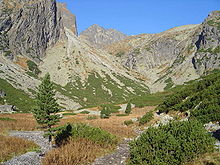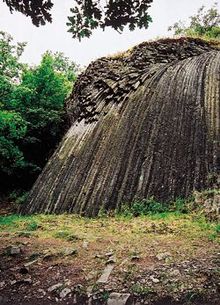Geology of the Western Carpathians

The
The geological evolution of individual parts of the chain is complex, a result of
Many aspects of the geological structure of the Western Carpathians have not been completely studied and are subject to ongoing research and debate. The appropriate classification of a number of specific tectonic units is still not clear.
Geological definition

The Western Carpathians are separated from the
Geological structure
There are several interpretations of the tectonic structure of the Western Carpathians. For quite a long time, the triple division has been used (
The three main areas of the Inner, Central, and Outer Western Carpathians are divided by two

Foreland
The foreland of the Western Carpathians in the West and North is composed of the
Outer Western Carpathians
The
Foredeep
Thrust of the Carpathians on their foreland caused a
Flysch Belt

The
Central Western Carpathians
The Central Western Carpathians, sometimes referred as the Slovakocarpathian system, was released to the flanks of the thrust belt, which caused the tectonic escape of the material. Central Western Carpathians were consequently pushed in the Northeast direction from the Alpine to Carpathian domain.
Považie-Pieniny Belt
The Považie-Pieniny Belt has a complicated imbricated structure, represented especially by the Pieniny Klippen Belt.[6] It consists of Oravic, Gossau Group, and Magura units, as well as Inner-Carpathian units (e.g. Manín and Drietoma unit etc.). Placement of the Pieniny Klippen Belt into the Central Western Carpathians is ambiguous, because most authors consider Pieniny Klippen Belt as part of the Outer Carpathians.[3] The Považie-Pieniny Belt is divided into three zones: the Brezová, Peri-Klippen, and Klippen zones.

Relatively thin and complicated, the
Tatra-Fatra Belt of core mountains

South of the Pieniny Klippen Belt, the zone of core mountains is present. The core is formed by the
Vepor Belt
The
Gemer Belt
The
Internal Western Carpathians
The Internal Western Carpathians are divided from the Central Western Carpathians by the Rožňava line, which is partly covered by the décollement nappes. The Rožňava line is largely a conceptual one and is perceived differently by different authors. According to assumptions, the fault joins the Raaba-Hurbanovo line on the West. Other problem of exact definition of boundary between the Internal and Central Western Carpathians are views of the structure of the Meliatic unit. The Internal Western Carpathians are composed generally of the tectonic units originating from the area of the former Meliata-Halstatt Ocean or South of it. This zone is built of the Meliata, Bükk, Transdanubian, and Zemplín Belt. There are large nappes of Mesozoic carbonates (Silicic, Meliatic, Tornaic), which are not affected by metamorphism and are characteristic with typical affinity to the South Alps-Dinaride facies.[6]
Meliata Belt
The
Bükk Belt
To the south of the previous area there is the
Transdanubian Belt
The Transdanubian or the Bakony Belt principal tectonic unit called the
Zemplín Belt
A tectonic unit of uncertain position is the
Post-nappe units
The Jurassic-Cretaceous tectonic structure was later changed by various types of the overstep complexes: the Central Carpathian Paleogene Basin, Buda Paleogene Basin, Vienna Basin (Neogene, pull-apart type), Pannonian Basin (or the Danube Basin), and the volcanic complexes: Neogene volcanics of Carpathians (or just Neovolcanis).[12]
Volcanism
Paleozoic and Mesozoic volcanism

The oldest forms of volcanism, which affected the area of the Western Carpathians, are hardly recognized because of later tectonic processes and destruction by erosion.
Significant volcanic activity took place in the Lower Paleozoic in the
Cenozoic volcanism

Post nappe volcanic activity in the Carpathians is simply called neovolcanism. It took place from the Neogene (Lower Badenian) to the Quaternary, mostly in the internal portion of the Carpathian arc (on a smaller scale also in the external Carpathians). Three main phases of the volcanic activity are distinguished:
- Acid volcanism – began in the lower Vtáčnik Mts. Rhyodacite tuffs in sediments of Lower Badenian are known in the Zemplín region of Eastern Slovakia.[17]
- Intermediate volcanism – started in the Lower Slanské vrchy Mts. Volcanoes of this phase are found also in Romania. The younger phase of volcanism is known in the area of Vihorlat Mts.[17]
- Basic volcanism – represented by alcaline rock, is found in Central and Southern Slovakia and Hungary. The prevailing rock type is basalt with phenocrysts of olivine or nepheline (basalts in the area of Banská Štiavnica). There were lava flows in the vicinity of the Ostrá Lúka near Zvolen and Devičie near Krupina, lava flows and maars in the vicinity of Pinciná, Jelšovec, lava flows, necks, dikes, and maars in Cerová vrchovina, and the youngest cinder cone, the Putikov vŕšok, near the Nová Baňa.[9]
Metamorphism
The occurrence of metamorphosed crystalline rock in the Western Carpathians is known from the
Caledonian metamorphism has not been clearly proved, but some signs are present in
Earthquakes
The Western Carpathians are from the
Quaternary deposits
The
References
- ^ a b Mísař, Z., 1987: Regionální geologie světa. Academia, Praha, 708 pp.
- ^ "On-line geologická encyklopedie". geology.cz. July 3, 2008.
- ^ a b c d e Mišík, M., Chlupáč, I., Cicha, I., 1984: Historická a stratigrafická geológia. Slovenské pedagogické nakladateľstvo, Bratislava, 541 pp.
- ^ a b c d e Maheľ, M., 1986: Geologická stavba československých Karpát. Paleoalpínske jednotky 1. Veda, Bratislava, 503 pp.
- ^ a b c d Plašienka, D., Grecula, P., Putiš, M., Kováč, M. a Hovorka, D., 1997: Evolution and structure of the Western Carpathians: an overview. Archived 2011-08-26 at the Wayback Machine in Grecula, P., Hovorka, D., Putiš, M. (Eds.) Geological evolution of the Western Carpathians. Mineralia Slovaca - Monograph, Košice, pp. 1 – 24
- ^ a b c d e Plašienka, D., 1999: Tektochronológia a paleotektonický model jursko-kriedového vývoja centrálnych Západných Karpát. Veda, 125 pp.
- ^ a b c d e Biely, A. (Editor) 1996: Explanation to geological map of Slovakia. Dionýz Štúr Publishers, Bratislava, 76 pp.
- ^ a b c Hók, J., Kahan, Š., Aubrecht, R., 2001: Geológia Slovenska. Archived 2011-07-19 at the Wayback Machine Univerzita Komenského, Bratislava, 43 pp.
- ^ a b Vozár, J., Vojtko, R., Sliva, Ľ., (Editors) 2002: Guide to geological excursion. XVIIth Congress of Carpathian-Balkan Geological Association. Dionýz Štúr Publishers, Geological survey of Slovak republic, Bratislava, 163 pp.
- ^ a b c d e Kováč, M., Plašianka, D., 2002: Geological structure of the Alpine-Carpathian-Pannonian junction and neighbouring slopes of the Bohemian Massif. Comenius University, Bratislava, 88 pp.
- ^ Tomek, Č., 1993: Deep crustal structure beneath the central and inner West Carpathians. Tectonophysics, 226, pp. 417–431
- ^ a b c d Plašienka, D. 2006: Princípy regionalizácie geologickej stavby Malých Karpát a Považského Inovca. In: Kováč, M., Dubíková, K., Nové metódy a výsledky v geológii Západných Karpát. Zborník 2006, pp. 51 – 56
- ^ a b Vozárová, A., Vozár, J., 1988: Late paleozoic in Western Carpathians. Geologický ústav Dionýza Štúra, Bratislava, 303 pp.
- ^ Putiš, M., Hrdlička, M. a Uher, P., 2004: Litológia a granitoidný magmatizmus staršieho paleozoika Malých Karpát. Mineralia Slovaca, 36, pp. 183 – 194
- ^ Hovorka, D., 1990: Sopky. Veda, Bratislava, 147 pp.
- ^ a b Ivan, P., 2002: Relics of the Meliata ocean crust: Geodynamic implications of mineralogical, petrological and geochmical proxies. Geologica Carpathica, 53, 4, s. 245–256
- ^ a b Konečný, V., Lexa, J., Šimon, L., Dublan, L., 2001: Neogénny vulkanizmus stredného Slovenska. Mineralia Slovaca 33, pp. 159–178
- ^ Putiš, M., Segeev, S., Ondrejka, M., Larionov, A., Siman, P., Spišiak, J., Uher, P., Paderin, I., 2008: Cambrian-Ordovician metaigneous rocks associated with Cadomian fragments in the West-Carpathian basement dated by SHRIMP on zircons: a record from the Gondwana active margin setting. Geologica Carpathica, 59, 1, pp. 3–18
- ^ Krist, E., Krivý, M., 1985: Petrológia. Alfa, Bratislava, 464 pp.
- ^ Krist, E., Korikovskij, S.P., Putiš, M., Janák, M., Faryad, S.W, 1992: Geology and petrology of metamorphic rocks of the Western Carpathian crystalline complexes. Comenius University Press, Bratislava, 324 pp.
- ^ Marko, F., 2004: Fault controlled evolution of the ALCAPA region. Geolines, 17, pp. 68–69
- ^ a b c d e Vaškovský, Imrich; Vaškovská, Eugenia (1981). "The development of the natural landscape in Slovakia during the Quaternary". Biuletyn Peryglacjalny. 28: 249–258.
